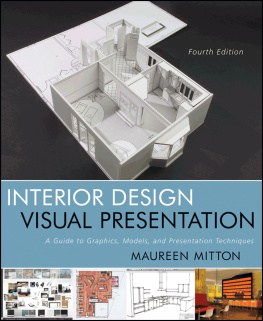STARTING YOUR CAREER AS AN
INTERIOR
DESIGNER

STARTING YOUR CAREER AS AN
INTERIOR
DESIGNER
ROBERT K. HALE & THOMAS L. WILLIAMS
WRITTEN WITH MURPHY HOOKER

2009 Thomas L. Williams and Robert K. Hale
All rights reserved. Copyright under Berne Copyright Convention, Universal Copyright Convention, and Pan-American Copyright Convention. No part of this book may be reproduced, stored in a retrieval system, or transmitted in any form, or by any means, electronic, mechanical, photocopying, recording, or otherwise, without prior permission of the publisher.
13 12 11 10 09 5 4 3 2 1
Published by Allworth Press
An imprint of Allworth Communications, Inc.
10 East 23rd Street, New York, NY 10010
Cover design by Derek Bacchus
Interior design by The Roberts Group
Page composition/typography by Integra Software Services, Pvt., Ltd., Pondicherry, India
Cover photo by TK
ISBN: 978-1-58115-725-3
eBook ISBN: 978-1-58115-725-3
Library of Congress Cataloging-in-Publication Data:
Hale, Robert K.
Starting your career as an interior designer / by Robert K. Hale and Thomas L. Williams.
p. m.
ISBN: 978-1-58115-725-3
1. Interior decorationVocational guidance. I. Williams, Thomas L., 1949- II. Title.
NK2116.H34 2009
747.092dc22
2008041105
Printed in the United States of America
DEDICATED TO NORMA C. WILLIAMS
Loving mother and
pioneering, entrepreneurial businesswoman
|
CONTENTS
Biography
CHAPTER 1
Designs on an Industry: Its Not a Job, Its an Adventure
CHAPTER 2
The State of Interior Design: Staking Your Claim in a Boom Industry
CHAPTER 3
Cutting Your Teeth in the Real World: Do You Have the Chops?
CHAPTER 4
Understanding Design Segments: The Art of Interior Design
Starting Your Career as an Interior Designer Series
CHAPTER 5
Plunging Off the Designer High Dive: On Starting Your Own Business
CHAPTER 6
Defining Your Dream: Understanding Models, Pricing, and Fees
CHAPTER 7
Marketing Your Business: Networking, Public Relations, and Advertising
CHAPTER 8
How to Attract Clients: Selling Yourself in the Design World
CHAPTER 9
Setting Up Your Design Studio: Getting It Right the First Time
CHAPTER 10
Building Your Village: Procurement, Delivery, and Installation
CHAPTER 11
Client Management: Game-Planning Your Design Business
FOREWORD
S ince you purchased this book, I can only assume that you want either to become an interior designer or to become a more successful one. In either case, it is clear that in Starting Your Career as an Interior Designer, you have found a resource of unprecedented value.
For over twenty years, I have studied the competitive nature of industries and taught entrepreneurship at the University of Texas at Austin. I have looked at fields as diverse as software, manufacturing, and retail. When, some years ago, I was presented with the opportunity to study the interior design industry, I came away with an unexpected, and as of yet unaltered, opinion: Interior design is the most complex industry I have ever seen.
I have often described being an interior designer as tantamount to trying to run a law firm (detail-oriented with a time-billing mentality), a construction firm (intricate coordination of people, places, and things to complete a job), and a group therapy session (keeping clients happy) all at the same time!
Intrigued, I expanded my field of research and discovered an even more astonishing factthe virtual absence of business education available for professionals in this challenging field. I found that the gap between the creative skills that are often innate and the business skills that must be learned is greater than in any other industry I have studied. This gap has only increased over the past five years as the challenges facing interior designers have grown more daunting, driven by forces that strategic planners would term creative destruction and collapsing value chains.
What this means to you is that the path to your profitability in the future will be very different from the one traveled by other designers in the past. You will need very different skills. The industry is being shaken by powerful forces, including the Internet, megastores, do-it-yourselfers, and a plethora of design magazines and television shows. You will have to know how to capitalize on these trends rather than be victimized by them.
Everyone, it seems, wants to be a designer today, which is somewhat surprising considering the challenges designers face. To be blunt, few are able to earn and sustain a good living. But there are factors that highly successful designers share. There are driving philosophies and core business practices that can dramatically boost your chances of success. And, fortunately for you, hundreds of these factors are contained in the pages of this landmark book.
In Starting Your Career as an Interior Designer, Robert K. Hale and Thomas L. Williams have done a masterful job of never shying away from the complexity of which I speak. Yet rather than succumb to the temptation of offering simple solutions, they put forward an array of strategic alternatives for you to choose from. Where necessary, they give full voice to opposing points of view. Skilled designers themselves, Hale and Williams go into great detail about the factors that determine a designers ability to remain viablefactors like competition and pricing wars, and even licensing and accreditation.
The bite-sized nuggets presented in each chapter, along with interspersed case studies in the voices of other designers, are just two of the many structural components that keep the pages of this book turning. It is anything but a boring business tome.
The authors describe the profession of interior design as an adventure, and the same could be said for reading this book. It is infused with an inspiring voiceyou can do ityet steeped in the business realities that the authors distinguished careers have provided.
Starting Your Career as an Interior Designer is destined to become a perennial book that designers and would-be designers will read for years to come, even as the industry continues its rapid transition.
In all critical areas, from the niche markets you may want to consider to the nature of competition and pricing, the authors have drawn not only on their combined fifty-plus years of experience, but also on their extensive research. This book is comprehensive in scope, yet echoing beyond the scholarship one hears the voices of the authors like those of a best friend and mentor. Hale and Williamstwo proven professionalstake less experienced designers by the hand, whisper sage counsel in their ears, and give them the courage and the confidence to go forward on their own.
The authors have been through the design wars and have not just seen, but have experienced, the wrenching changes of an industry in transition. They have adapted, and despite the award-winning design work of their own creation, one cant help but wonder if this book wont be their ultimate legacy to the world of interior design. While others might write books about color, form, or function, Hale and Williams have gone to the very heart of the future of design: If its practitioners cant manage the complexity of the business side of things, they will not have the time or the financial resources to express their creative artistry. The result will be a sea of corporate, cookie-cutter design commodities masquerading as art.
Next page










